In today’s fast-digitizing world, the race is among businesses to stay ahead in the competitive world of online marketing.
And one of the key players within it all would be Shopping Ads.
In fact, besides just reinventing the way customers discover and buy anything online, they have become a significant revenue driver for brands in almost any industry.
As we understand the 2023 extension of Shopping Ads, let’s unravel a few growth trends and opportunities this great ad format provides.
Whether you’re an advanced or new marketer, the knowledge of Shopping Ads will open up the latest avenues for success in your campaigns.
Let us understand more about this ad option.
The digital world of marketing has evolved and keeps changing, and so has the popularity of Google Shopping Ads grown hugely in no time.
These ads allow companies to showcase products directly within search results for a more visual and informative customer shopping experience.
But how do Shopping Ads work, really, and why are they so integral to businesses desiring success in today’s marketplace?
Let’s look deeper into the basics of Shopping Ads and see what makes them unique.
- What Are Shopping Ads? Understanding the Basics
- The 2023 Expansion: Key Growth Trends in Shopping Ads
- Opportunities for Companies within the Expanding Shopping Ads Landscape
- Optimizing Shopping Ads Campaigns for Success
- The Future of Shopping Ads: What to Expect Beyond 2023
- Conclusion: How to Maximize Growth with Shopping Ads in 2023 and Beyond
- Commonly Asked Questions About Shopping Ads in 2023 and Beyond
What Are Shopping Ads? Understanding the Basics
Shopping Ads are a specialized ad format used mainly on different platforms like Google to showcase products online.
These ads are visually rich and provide critical product information, such as images, prices, names of stores, and product descriptions at the top of search engine results.
This format makes it easier for users to find what they need without necessarily having to go into multiple links and pages.
Shopping Ads work through integrating a retailer’s product feed with Google’s ad platform, whereby the most relevant Shopping Ad shows for a query that matches the title, description, or other attributes of the product which the user types in.
This lets businesses reach customers who are already oriented towards purchasing something like theirs, making this an awfully effective way to drive traffic and conversions.
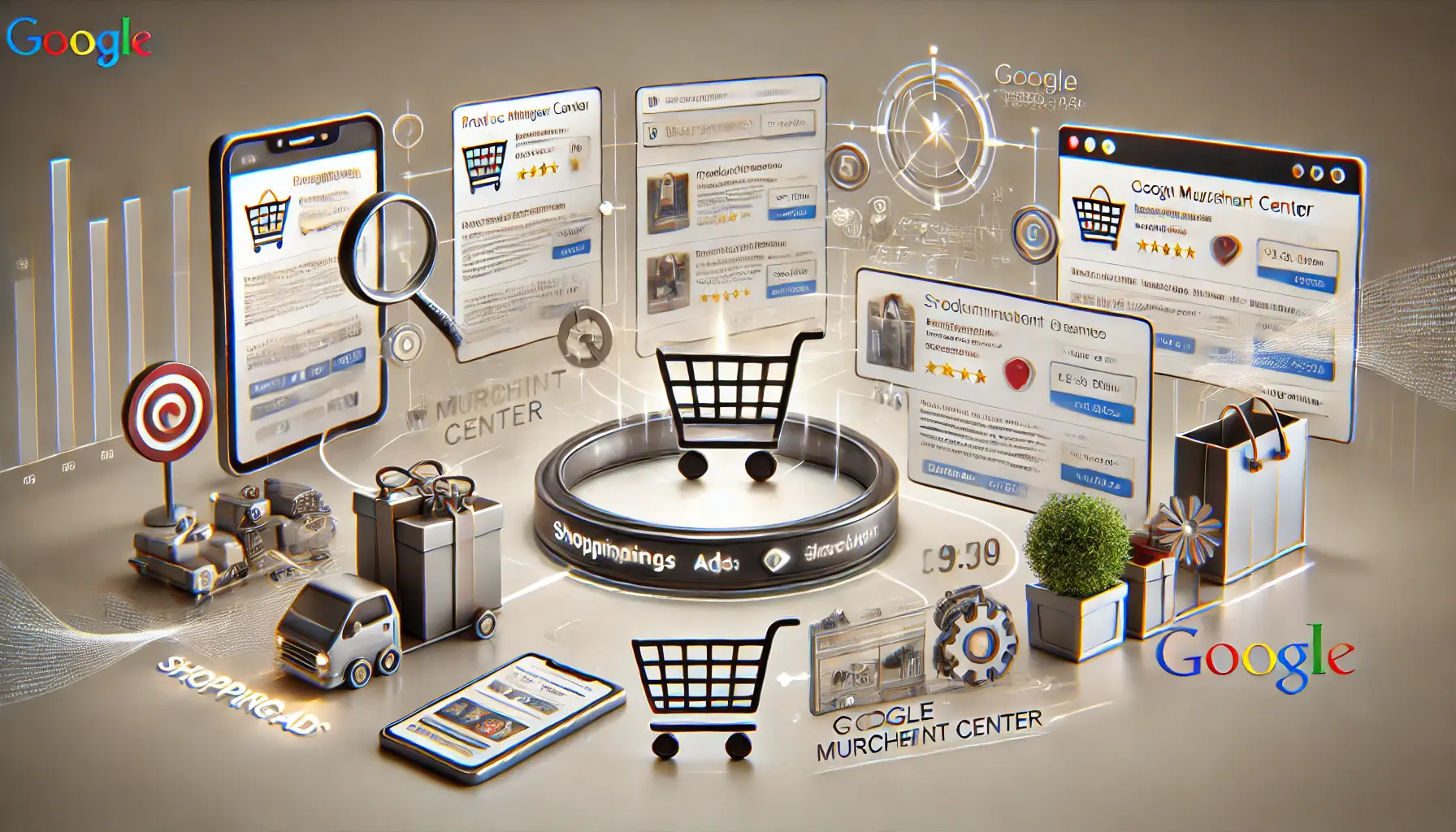
Understanding the process of Shopping Ads integration.
How Shopping Ads Work
Shopping Ads work by utilizing a product feed — a file of structured data that contains information about each product a retailer would like to advertise.
The feed is uploaded to various platforms, including Google Merchant Center, and is then linked with the Google Ads account.
Subsequently, Google will look through data included in the feed to match it against relevant search queries.
Once there is a match, the product ad is displayed in front of the users.
- Information included in the feed for the product pertains to the title, description, price, and images of the products.
- Through these, Google compares that data to the search queries that it receives to know which ads it should show.
- Because businesses only pay whenever users actually click on their ads, the solution is quite cost-effective.

Understanding the types of Shopping Ads for e-commerce success.
Types of Shopping Ads
The most common types of Shopping Ads are:
- Product Shopping Ads: These are the standard Shopping Ads, which show individual products to users based on search queries.
- Showcase Shopping Ads: These ads group together multiple related products, allowing users to explore a wider selection within a single ad.
- Local Inventory Ads: These ads let users know what products are available in nearby physical stores, providing a strong way of driving foot traffic into retail.
Each of these Shopping Ads types offers something very different and can be used strategically for different target audiences.
Product Shopping Ads work wonders when there are specific items, but when it comes to collections or sets of products, Showcase Shopping Ads will do the job just right.
Shopping Ads come with a set of tools that any business would look forward to capturing customers’ attention and, eventually, sales, as you have seen.
But the real power of these comes in their ability to reach users who are already in search of the products you offer, and who bear a greater potential of bringing value to your business that seeks to grow its online presence.
Shopping Ads provide detailed product information in search results, making it easier for users to find relevant products quickly and efficiently.

Key growth trends in Shopping Ads during 2023.
The 2023 Expansion: Key Growth Trends in Shopping Ads
Shopping Ads continued to grow at a strong rate in 2023, further solidifying their place as one of the juggernauts in the digital advertising arena.
The pandemic and overall affinity for online shopping have created a tectonic shift toward e-commerceElectronic commerce, or the buying and selling of goods and services over the internet., with Shopping Ads becoming increasingly relevant.
In today’s crowded marketplace, where brands fight for consumer attention, leveraging the latest trends in Shopping Ads to stay visible and drive conversions is essential.
Throughout this year, we have seen several key trends shape the expansion of Shopping Ads.

A global market overview highlighting e-commerce trends in 2023.
Market Overview for 2023
The e-commerce market at large has seen remarkable growth, with Shopping Ads being one of the key drivers behind this expansion.
As consumers become more comfortable making purchases online, businesses are investing more in Shopping Ads to capture the growing market.
According to recent reports, spending on Google Shopping Ads is more than 25% higher in 2023, with more businesses continuing to use these ads more effectively to reach online shoppers.
- Mobile shopping is huge, with a high percentage of clicks on Shopping Ads coming from mobile devices.
- Brands have increasingly relied on data-driven strategies, implementing AI and machine learning to optimize their Shopping Ads for better performance.
- Automation has become much more advanced for campaign management, allowing marketers to scale campaigns efficiently.

Top industries adopting Shopping Ads in 2023, from fashion to electronics.
Top Industries Adopting Shopping Ads
In 2023, several industries have emerged as leaders in adopting Shopping Ads.
Some of the top verticals that rely on this ad format to showcase their products include retail, fashion, electronics, and home goods.
These industries are particularly well-suited to the visual and interactive nature of Shopping Ads, providing a seamless shopping experience for customers directly within search results.
- Fashion and Apparel: With the rise of fast fashion and increased demand for online shopping, fashion brands have been major adopters of Shopping Ads, using them to highlight new collections and seasonal promotions.
- Electronics: The tech industry, particularly companies selling smartphones, laptops, and home electronics, has seen significant growth in its use of Shopping Ads, capitalizing on the visual appeal of product images.
- Home Goods and Furniture: As more consumers invest in home improvements, businesses in this sector have used Shopping Ads to showcase everything from furniture to decor, driving substantial traffic and sales.
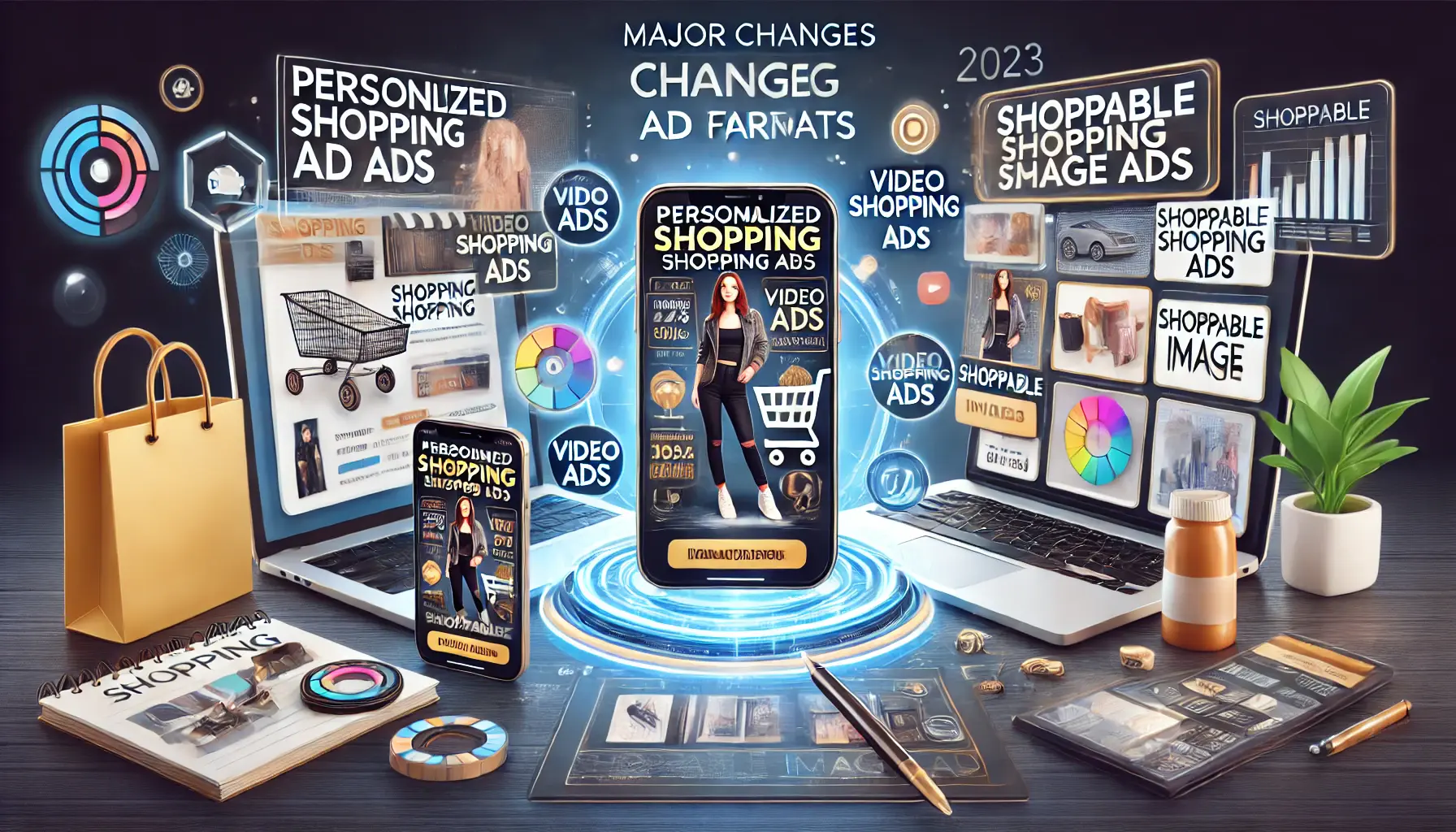
Exploring the major changes in Shopping Ad formats for 2023.
Major Changes in Ad Formats
2023 has brought several enhancements to Shopping Ads formats, making them more versatile and effective.
Google has added personalization features, enabling ads to be tailored to user experiences based on their browsing history and previous engagements with brands.
Additionally, video is being introduced into Shopping Ads, allowing brands to showcase products dynamically and engagingly.
- Personalized Shopping Ads: AI dynamically displays products aligned with users’ interests, making the shopping experience more relevant and likely to convert.
- Video Shopping Ads: Video content is being used within Shopping Ads for enhanced product views and visuals for buyers.
- Shoppable Image Ads: This format allows users to click directly on images within Google search and discover products featured in the image, enhancing the visual appeal of Shopping Ads.
These new formats and trends in Shopping Ads are helping businesses of all sizes reach more customers, drive more traffic, and ultimately increase sales.
Given the continued development of Shopping Ads, it is clear they will remain an integral part of digital marketing strategies for many years ahead.
In 2023, Shopping Ads continue to grow as a vital part of digital marketing, especially with the rise of mobile shopping and data-driven strategies.

Exploring growth opportunities for companies within the expanding Shopping Ads landscape.
Opportunities for Companies within the Expanding Shopping Ads Landscape
With Shopping Ads still growing strong into 2023, businesses are faced with plenty of opportunities where this powerhouse tool can continue to be leveraged to extend their online presence and amplify sales.
Driving the increasingly sophisticated technology behind Shopping Ads is the capability to reach an extremely targeted audience, drive conversions, and optimize marketing budgets more effectively.
In this section, we will explore the most promising opportunities that businesses can capitalize on in this ever-evolving Shopping Ads landscape.

Reaching new markets with Shopping Ads globally.
Targeting New Markets
One of the most promising opportunities for businesses using Shopping Ads is targeting new markets.
E-commerce has peaked, and people from every region and demographic are shopping online more than ever.
This means companies can reach new audiences by expanding their ad campaigns beyond local markets.
Advanced targeting capabilities within Google let advertisers reach specific regions, languages, and even devices, making it easier to reach consumers globally.
- Global Reach: With Shopping Ads, businesses can easily reach international consumers and expand their operations. They can also devise localized campaigns across different regions by considering local preferences, buying behavior, and seasonal changes.
- Device-Specific Targeting: Businesses can optimize their campaigns to target either mobile, desktop, or both, depending on how their target audience interacts with each device.

AI-driven tools optimizing Shopping Ads for better campaign performance.
Utilizing AI for Optimized Campaigns
With greater access to AIArtificial Intelligence, the simulation of human intelligence in machines programmed to think and learn.-driven tools in 2023, businesses can make data-driven decisions faster than ever.
These tools automatically help advertisers adjust bids, find the right customers, and boost overall campaign performance.
- Smart Bidding: AI-driven bidding strategies, such as Target ROAS (Return on Ad Spend) and Target CPA (Cost per Acquisition), enable advertisers to automatically set the best bid for every ad placement.
- Automated Targeting: AI algorithms analyze customer behavior and preferences to present highly personalized ads to the target audience.
- Real-Time Optimization: AI enables businesses to continuously optimize their campaigns. As trends change, AI adjusts ad performance in real time to maximize returns and minimize ad waste.

Boosting ROI through optimized Shopping Ads campaigns.
Maximizing Return on Investment (ROI)
Shopping Ads are highly effective in maximizing return on investment (ROI), largely because of their visual nature, which fosters better click-through rates (CTRClick-Through Rate, a metric that measures the percentage of people who click on an ad after seeing it.) and conversion rates compared to traditional text ads.
Additionally, targeting customers who are already searching for specific products enables businesses to generate more qualified leads, improving marketing budget efficiency.
- Higher CTRs: The visually rich format of Shopping Ads tends to drive more clicks from users who are ready to make a purchase.
- Improved Conversion Rates: Customers who click on Shopping Ads are often further along in the buying process, resulting in higher conversion rates and increased sales.
- Cost-Effective Marketing: Shopping Ads operate on a pay-per-click basis, meaning that businesses only pay for ads that generate user interest, making it a cost-effective marketing solution.
By leveraging these opportunities, businesses can unlock significant growth potential and gain a competitive edge within the expanding Shopping Ads landscape.
Shopping Ads enable businesses to reach targeted audiences globally, optimize campaigns with AI, and maximize ROI through data-driven strategies.

Optimizing Shopping Ads campaigns for better performance and success.
Optimizing Shopping Ads Campaigns for Success
As far as 2023 is concerned, the art of fully leveraging Shopping Ads by a business rests in how well the company optimizes its campaigns for efficiency and performance.
When done appropriately, Shopping Ads can drive considerable traffic, enhance conversions, and increase overall sales.
This section will cover important optimization techniques that will enable a business to get the most out of its Shopping Ads campaigns.
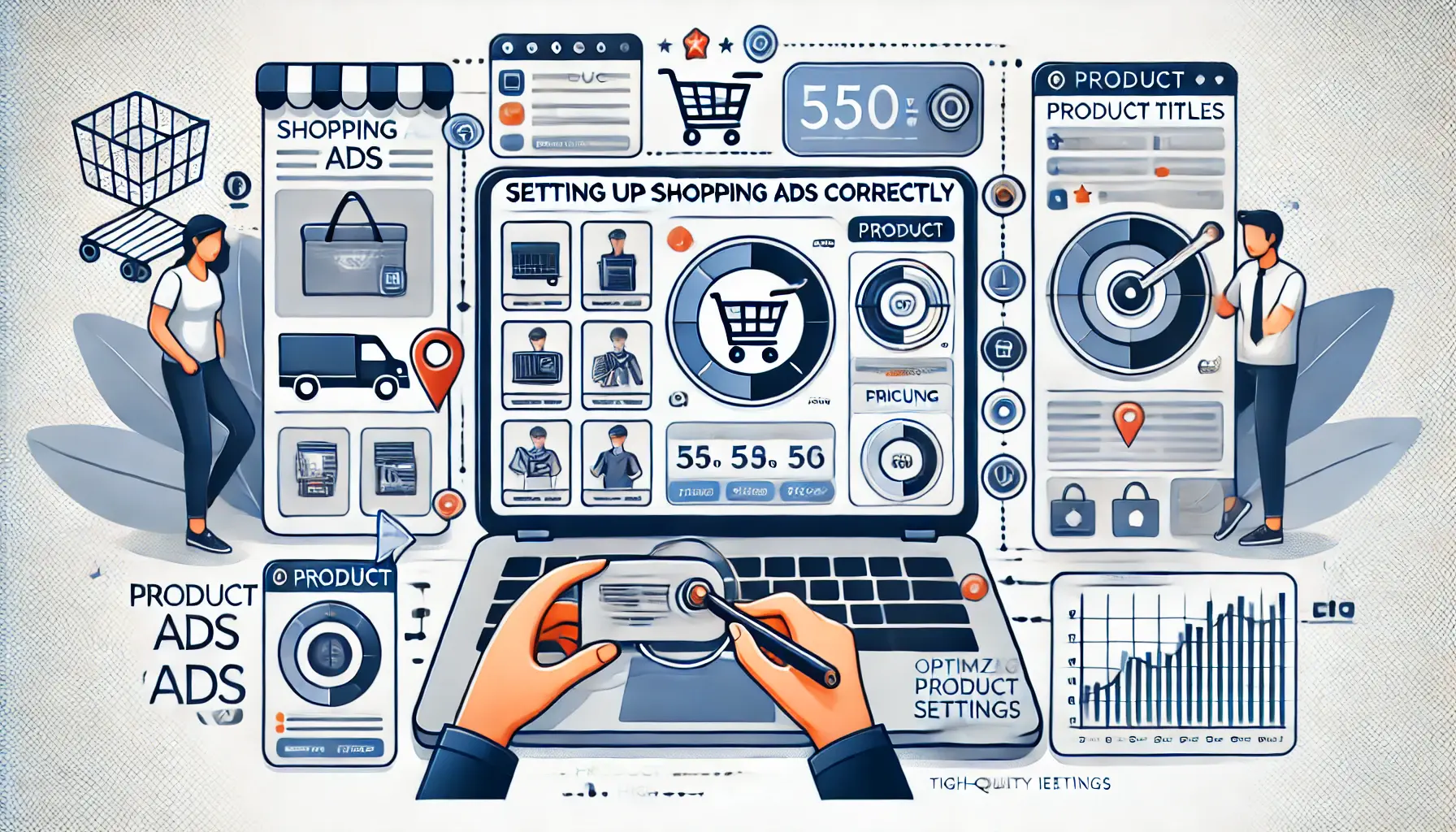
Setting up Shopping Ads accurately for optimal performance.
How to Set Up Your Ads Right
Setting up Shopping Ads successfully begins with proper ad setup.
It is necessary to ensure product data is accurate, complete, and aligned with search queries to enhance ad performance.
Detailed and optimized product information is key, as Google’s algorithms heavily rely on the product feed to deliver relevant ads.
- High-Resolution, Clear Product Images: Use high-quality, clear images that accurately represent your products. Poor-quality images lead to lower click-through rates (CTR) and decreased conversions.
- Optimized Product Titles and Descriptions: Ensure product titles and descriptions are keyword-rich and detailed, reflecting the types of searches customers may use.
- Accurate Pricing and Availability: Keep pricing and stock availability up to date to avoid ad disapproval or poor user experiences.

Managing Shopping Ads budgets effectively for maximum ROI.
Effective Budget Management
Whatever the size of the company, whether small or large, wise budget allocation is crucial to achieve a better return on investment (ROI).
Here are some effective ways to manage your budget:
- Segment Campaigns by Product Categories: Group products into categories based on profitability. This allows you to allocate more budget to high-performing products while cutting down on spending for poorer-performing ones.
- Set Realistic Bids: Leverage Google’s Smart Bidding strategies, such as Target ROAS (Return on Ad Spend) or Target CPA (Cost Per Acquisition), which automatically sets the right bids for your desired outcomes.
- Monitor Budget Regularly: Track performance metrics and adjust your daily budget based on the results. Increase spending on high-converting products and reduce it for low performers.
Tracking performance metrics for Shopping Ads to enhance campaign success.
Tracking Performance and Metrics
Tracking performance is vital for identifying what works and what doesn’t in your Shopping Ads campaign.
By analyzing key performance metrics, you can continuously improve your strategy and optimize your ads for better results.
- Monitor Click-Through Rates (CTR): A higher CTR indicates that your ads are resonating with your audience. If your CTR is low, consider revising product titles, descriptions, and images.
- Track Conversion Rates: Monitor how many clicks turn into actual sales. A high conversion rate indicates that your ads are targeting the correct audience.
- Analyze Return on Ad Spend (ROAS): Use ROAS to measure your campaign’s effectiveness. A positive ROAS shows good value from your investments, while a negative ROAS indicates areas that need improvement.
By following these Shopping Ads optimization techniques, businesses can ensure that their Shopping Ads campaigns run efficiently and yield the best possible results.
The key is continuous monitoring and adjustment to ensure your ads are performing at their peak potential.
Optimizing product data, managing budgets wisely, and tracking key metrics like CTR and ROASReturn on Ad Spend, a marketing metric used to evaluate the efficiency of an advertising campaign. are crucial for successful Shopping Ads campaigns.

The future of Shopping Ads beyond 2023 with emerging technologies.
The Future of Shopping Ads: What to Expect Beyond 2023
The evolution of Shopping Ads has been rapid, and looking beyond 2023, the future promises to become even more fascinating.
With continuous advancements in digital marketing technologies, Shopping Ads are expected to become more sophisticated, interactive, and personalized, offering businesses even greater opportunities to reach their target audience.
Key trends that will shape the future of Shopping Ads and what businesses can expect in the years to come are discussed here.

Predictions for Shopping Ads in 2024 and beyond with advancements in AI and virtual shopping.
Predictions for 2024 and Beyond
Experts forecast that the growth in e-commerce and demand for visually appealing ad formats will continue beyond 2023, driving the adoption of Shopping Ads.
The integration of new technologies, such as AI, ARAugmented Reality, a technology that superimposes digital content onto the real world., and machine learning, will further enhance user experience while strengthening ad performance.
These technologies will help businesses provide more targeted and personalized advertisements while developing more interactive and immersive shopping experiences.
Some of the innovative features you might see in Shopping Ads include:
- AI-Powered Personalization: AI will play a huge role in automating and personalizing Shopping Ads. Advertisers will be able to deliver highly relevant content to users based on their browsing behavior and purchase history.
- AR Integration: AR will be increasingly integrated into Shopping Ads, allowing users to virtually interact with products. For instance, customers could see how furniture fits into their home before making a purchase.
- Voice Search Optimization: The rise of voice-enabled devices, like smart speakers, will push Shopping Ads to be optimized for voice search, allowing businesses to tap into this growing segment of the market.

The impact of evolving technologies like AI and 5G on Shopping Ads.
Evolving Technologies Impacting Shopping Ads
Emerging technologies will soon revolutionize how Shopping Ads are created, displayed, and interacted with.
Businesses that keep pace with these trends will have a competitive edge in capturing consumer attention and driving sales.
Some of the key technologies shaping the future of Shopping Ads include:
- 5G Connectivity: With the rollout of 5G, internet speeds will increase, allowing for more data-heavy and interactive Shopping Ads, such as video ads and immersive 3D product visualizations.
- Automation Tools: Automation will continue to simplify Shopping Ads management. Advanced tools will make real-time campaign optimization easier for advertisers.
- Blockchain for Ad Transparency: Blockchain has the potential to enable greater transparency and trust in Shopping Ads, allowing businesses to verify ad placements and reduce fraud.

Exploring emerging market opportunities for Shopping Ads.
Emerging Market Opportunities
As Shopping Ads evolve, new market opportunities will emerge, especially in untapped regions and demographics.
The expansion of e-commerce into developing markets presents a great opportunity for businesses to grow their online presence and reach new audiences.
Additionally, the increased use of mobile shopping and digital wallets in these regions means businesses need to adjust their Shopping Ads strategy to cater to these trends.
- Mobile-First Markets: Many developing markets are mobile-first, which means businesses must prioritize mobile-optimized Shopping Ads to reach these consumers effectively.
- Cross-Border E-Commerce: As international shipping and payment solutions improve, cross-border e-commerce will become more accessible, allowing businesses to expand their reach into new markets through Shopping Ads.
- Localized Shopping Experiences: Customizing Shopping Ads for local preferences and cultural nuances will be essential for success in emerging markets, where consumer behavior differs from more established regions.
The future of Shopping Ads is bright, full of innovation and growth.
As technologies and market trends continue to evolve, businesses that stay ahead of these changes will be well-positioned to thrive in the competitive e-commerce landscape.
The future of Shopping Ads includes AI-powered personalization, AR integration, and voice search optimization to create more interactive shopping experiences.
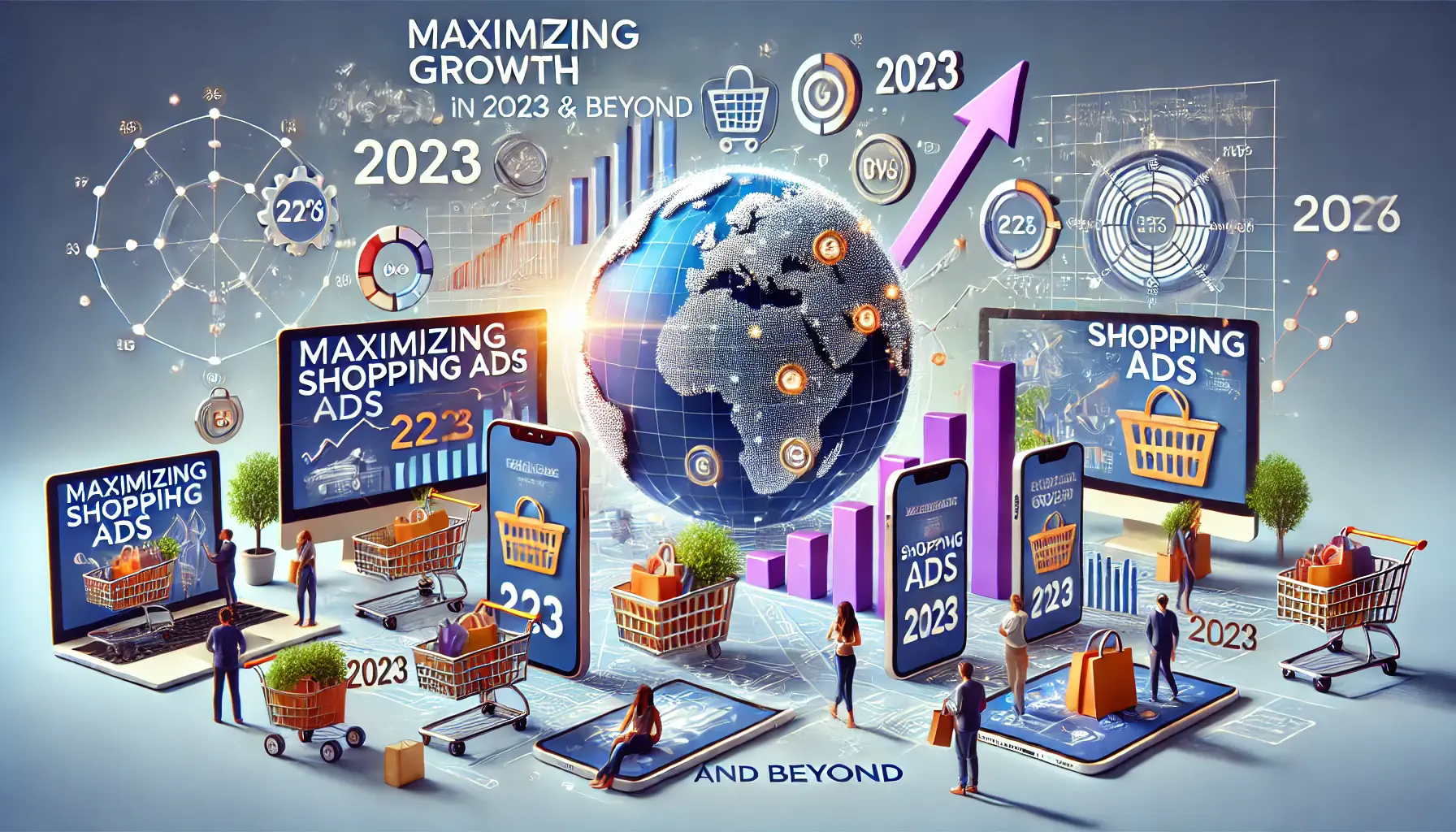
Maximizing growth with Shopping Ads strategies in 2023 and beyond.
Conclusion: How to Maximize Growth with Shopping Ads in 2023 and Beyond
The continued growth and evolution within Shopping Ads make this ad format an absolute must-have for any business that wants to succeed in today’s competitive digital marketing world.
Shopping Ads will continue to play a significant role in how companies engage their audiences, driving traffic and sales in 2023 and beyond.
Advanced technologies and effective campaign optimization can unlock tremendous growth possibilities for businesses.

The power of Shopping Ads in driving e-commerce success in a changing world.
The Power of Shopping Ads in a Changing E-Commerce World
With exponential growth in e-commerce, Shopping Ads have proven to be one of the most effective methods for businesses to reach highly targeted customers.
They are the only ad type that boasts AI-powered personalization, augmented reality integration, and voice search optimization, offering shoppers an immersive experience directly on the search screen.
Beyond their innovative features, the ability to reach new markets, optimize campaigns in real-time, and maximize return on investment makes Shopping Ads a powerful tool for businesses of any size.
With mobile-first and cross-border e-commerce markets on the rise, businesses have endless possibilities to expand their reach by adopting tailored ad strategies.

Optimizing Shopping Ads campaigns for success with data-driven strategies.
Optimization Strategies for Success
From setting up ads correctly to managing budgets and tracking performance metrics, businesses need to refine their strategies for optimal performance.
Key areas for optimization include:
- Product Data Accuracy and Optimization: Ensure high-quality images, keyword-rich titles, and up-to-date pricing for best results.
- Effective Budget Management: Segment campaigns and use smart bidding strategies to maximize value from ad spend.
- Track Key Metrics: Monitoring click-through rates (CTR), conversion rates, and return on ad spend (ROAS) allows businesses to continuously improve their campaigns.

Exploring innovations and opportunities in the future of Shopping Ads.
The Future of Shopping Ads: Innovations and Opportunities Ahead
The future looks bright for Shopping Ads, with emerging technologies such as 5G connectivity, blockchainA decentralized digital ledger used to securely record transactions across multiple computers. transparency, and new automation tools offering new ways to boost ad performance.
Businesses that stay on the cutting edge of these innovations will have a competitive advantage, especially in emerging and mobile-first markets.
By embracing these technologies and adapting to changing consumer behaviors, businesses can maximize the full potential of Shopping Ads to reach broader audiences, increase engagement, and drive overall sales.
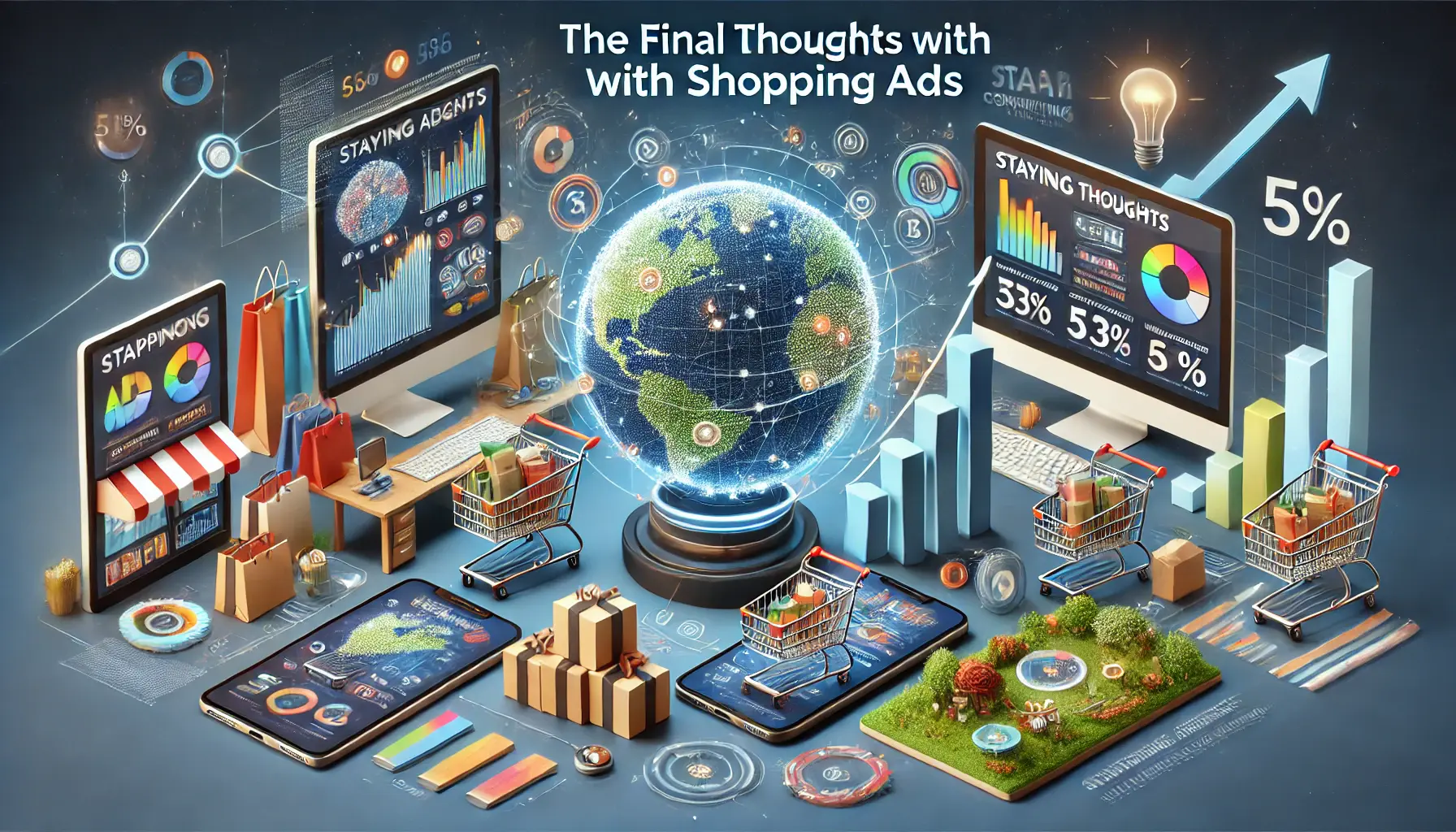
Staying ahead in the competitive digital advertising world with Shopping Ads.
Final Thoughts: Stay Ahead with Shopping Ads
Shopping Ads will form a crucial part of any successful digital marketing strategy in 2023 and beyond.
To stay ahead in the competitive e-commerce landscape, businesses must focus on constant optimization, embrace new technologies, and expand into new markets.
Investing in this robust ad format ensures long-term success, as Shopping Ads will continue to be a mainstay in marketing strategies as the digital world evolves for growth and innovation well into the future.
Shopping Ads will continue to play a key role in digital marketing strategies, offering businesses a powerful way to engage audiences and drive sales.

Addressing commonly asked questions about Shopping Ads in 2023 and beyond.
Your campaigns can be managed by an agency specialized in Google Ads, check out our service page.
Commonly Asked Questions About Shopping Ads in 2023 and Beyond
Here are some of the most frequently asked questions related to Shopping Ads and their role in the future of digital marketing.
These answers will help clear any ambiguity and provide insights into how you can optimize your Shopping Ads campaign for better performance.
Shopping Ads are visual ad formats that display product details, such as images and prices, directly within search results.
They rely on a product feed to target user queries and drive relevant traffic toward your business.
Technologies like AI, augmented reality (AR), 5G connectivity, and blockchain are shaping the future of Shopping Ads.
These innovations enhance ad personalization, interaction, transparency, and performance, creating better user experiences and driving more sales.
Optimizing Shopping Ads involves ensuring proper product data, high-quality images, and keyword-rich titles and descriptions.
Effective budget management, smart bidding, and tracking metrics like CTR and ROAS are essential for better ad performance.
Shopping Ads offer greater visual appeal, higher click-through rates, and more targeted traffic than traditional text-based ads.
They provide detailed product information directly in search results, improving the shopping experience for customers.
Shopping Ads enable advertisers to reach new markets by using advanced targeting features.
Campaigns can be tailored to specific geographic regions, languages, and devices, expanding the advertiser’s reach to a global audience.
Businesses can optimize Shopping Ads for mobile-first markets by focusing on mobile-friendly product pages, fast-loading ads, and clear visuals.
Mobile-optimized ads effectively cater to the growing mobile audience, especially in developing markets.












